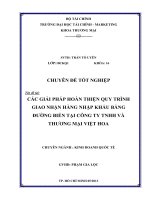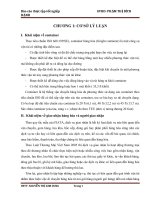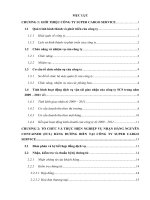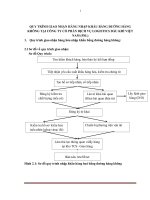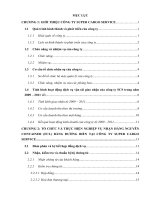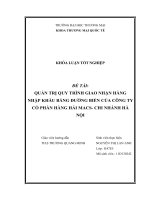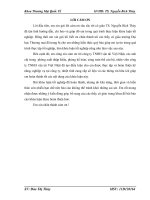Quy trình giao nhận xuất nhập khẩu bằng đường biển đi Mỹ tại công ty Super cargo service
Bạn đang xem bản rút gọn của tài liệu. Xem và tải ngay bản đầy đủ của tài liệu tại đây (2 MB, 90 trang )
THE UNIVERSITY OF DANANG
UNIVERSITY OF ECONOMICS
FACULTY OF INTERNATIONAL BUSINESS
BACHELOR’S THESIS
TOPIC:THE PROCESS OF FREIGHT FORWARDING FOR
EXPORT BY SEA TO THE US MARKET AT SUPER CARGO
SERVICE DANANG JOINT STOCK COMPANY
Student
Class
:
:
Instructor
Da Nang, May 2022
:
THE UNIVERSITY OF DANANG
UNIVERSITY OF ECONOMICS
FACULTY OF INTERNATIONAL BUSINESS
BACHELOR’S THESIS
TOPIC:THE PROCESS OF FREIGHT FORWARDING FOR
EXPORT BY SEA TO THE US MARKET AT SUPER CARGO
SERVICE DANANG JOINT STOCK COMPANY
Student
Class
:
:
Instructor
Da Nang, May 2022
:
COMMITMENT
I assure the topic “The process of freight forwarding for export by sea to the US
market at Super Cargo Service DaNang Joint Stock Company ” is an independent
research project under the guidance of instructor Ms. Dinh Tran Thanh My, MBA.
Also without any duplication of others. The content of the research is the product that I
have been trying to research during my study at Danang University of Economics as
well as participating in an internship at Super Cargo Service Da Nang. The data and
results presented in the research are completely honest. In addition, under the guidance
of the Faculty of International Business, I also used Turitin application to check
plagiarism. As a result, my research has a similarity to other sources of 3%. Please
take full responsibility to the faculty and the university if there is a problem.
DaNang, 26th May 2022
The writer
i
ACKNOWLEDGEMENTS
In order to complete the bachelor thesis, I would like to thank the Board of Director of
Super Cargo Service, the lecturers of the Faculty of International Business, Danang
University of Economics for giving me the opportunity to learn and study knowledges
of Foreign Trade major.
I would like to say thank you to my instructor Ms. Dinh Tran Thanh My, MBA, a
lecturer of the Faculty of International Business, who helped me to complete my
bachelor’s thesis.
I would like to express my gratitude to all officers of Super Cargo Service, who
helped me for my internship at the company..
Especially, I would like to thank the leader of sales team at Super Cargo Service, Mrs
Do Dieu Hang. In the process of implementing this bachelor thesis, in spite of my
efforts, I could not avoid mistakes. I look forward to receiving your feedbacks to
improve this thesis.
Thank you very much!
A student of the Faculty of International Business
The University of Danang – University of Economics
ii
INSTRUCTOR’S COMMENT
......................................................................................................................................
......................................................................................................................................
......................................................................................................................................
......................................................................................................................................
......................................................................................................................................
......................................................................................................................................
......................................................................................................................................
......................................................................................................................................
......................................................................................................................................
......................................................................................................................................
......................................................................................................................................
......................................................................................................................................
......................................................................................................................................
......................................................................................................................................
......................................................................................................................................
......................................................................................................................................
......................................................................................................................................
Da Nang, 05/2022
Instructor
iii
REVIEW LECTURER’S COMMENT
......................................................................................................................................
......................................................................................................................................
......................................................................................................................................
......................................................................................................................................
......................................................................................................................................
......................................................................................................................................
......................................................................................................................................
......................................................................................................................................
......................................................................................................................................
......................................................................................................................................
......................................................................................................................................
......................................................................................................................................
......................................................................................................................................
......................................................................................................................................
......................................................................................................................................
......................................................................................................................................
......................................................................................................................................
Da Nang, 05/2022
Review lecturer
iv
TABLE OF CONTENT
INTRODUCTION .................................................................................................. 1
1. Rationale ......................................................................................................... 1
2. Research subjects and scopes ......................................................................... 2
3. Objectives of the study ................................................................................... 2
4. Structure of the study ..................................................................................... 2
CHAPTER 1. THEORICAL FRAMEWORK OF FREIGHT FORWADING
SERIVCE FOR EXPORT BY SEA ................................................ 3
1.1. Logistics service ............................................................................................. 3
1.1.1. Definition of service ............................................................................... 3
1.1.2. The characteristics of service .................................................................. 3
1.1.3. Definition of logistics service ................................................................. 4
1.1.4. Definition of service quality ................................................................... 4
1.1.5. Definition of logistics service quality ..................................................... 4
1.2. Overview of freight forwarding .................................................................... 5
1.2.1. The concept of freight forwarding .......................................................... 5
1.2.2. Role of freight forwarding ...................................................................... 5
1.2.3. Features of freight forwarding ................................................................ 6
1.3. Participants in the freight forwarding services industry ............................. 7
1.3.1. Forwarder ............................................................................................... 7
1.3.1.1. Overview of forwarder ...................................................................... 7
1.3.1.2. Rights and obligations of the forwarder ............................................. 8
1.3.1.3. Responsibilities of the forwarder ....................................................... 9
1.3.2. Customer ................................................................................................ 9
1.3.2.1. Overview of customer ....................................................................... 9
1.3.2.2. Rights and obligation of customer ..................................................... 9
1.3.2.3. Responsibility of customers ............................................................. 10
1.3.3. Shipping line (Carrier) .......................................................................... 10
v
1.3.3.1. Overview of shipping line................................................................ 10
1.3.3.2. Rights and obligations of shipping line ............................................ 10
1.3.3.3. Responsibility of shipping line ........................................................ 10
1.3.4. Customs department ............................................................................. 11
1.3.4.1. Overview of custom department. ..................................................... 11
1.3.4.2. Rights and obligations of customs department ................................. 11
1.3.4.3. Responsibility of custom department ............................................... 11
1.4. General process and related documents in freight forwarding for export by
sea ..............................................................................................................12
1.4.1. General process of freight forwarding for export by sea........................ 12
1.4.2. Main documents used in the process of forwarding export goods by sea15
1.4.2.1. Certificate of original (C/O)............................................................. 15
1.4.2.2. Commercial Invoice ........................................................................ 16
1.4.2.3. Packing List ..................................................................................... 17
1.4.2.4. Bill of Lading .................................................................................. 18
1.4.2.5. Customs Declaration form ............................................................... 19
1.5. Logistics service quality assessment ............................................................20
1.5.1. Time ..................................................................................................... 20
1.5.2. Dependability ....................................................................................... 21
1.5.3. Communication .................................................................................... 21
1.5.4. Convenience ......................................................................................... 21
CHAPTER 2. METHODOLOGY ....................................................................... 22
2.1. Data collection ..............................................................................................22
2.1.1. Definition of data collection ................................................................. 22
2.1.2. The data collecting process ................................................................... 22
2.2. Observational method ..................................................................................22
2.2.1. The definition of observational method ................................................ 22
2.2.2. Observational technique ....................................................................... 23
vi
2.2.3. Observational sheet .............................................................................. 23
2.3. Document analysis ........................................................................................24
2.3.1. The definition of document analysis ..................................................... 24
2.3.2. The document analysis process ............................................................. 24
2.4. Semi-structure interview ..............................................................................25
2.4.1. The definition of semi-structure interview ............................................ 25
2.4.2. The process of semi-structured interview .............................................. 25
CHAPTER 3. OVERVIEW OF SUPER CARGO SERVICE COMPANY ....... 30
3.1. Introduction about Super Cargo Service company ....................................30
3.1.1. Company formation and development .................................................. 30
3.1.2. Organizational structure and functions of department ........................... 31
3.1.3. Main services of company .................................................................... 33
3.1.3.1. Sea & Air freight forwarding ........................................................... 33
3.1.3.2. Cross-border .................................................................................... 34
3.1.3.3. Break bulk & Project cargo handling ............................................... 34
3.1.3.4. Custom brokerages .......................................................................... 35
3.1.3.5. Inland Transportation ...................................................................... 35
3.1.3.6. Warehouse & Distribution ............................................................... 35
3.2. Result of business activities ..........................................................................35
3.2.1. Market revenue structure ...................................................................... 35
3.2.2. Result of business activities .................................................................. 37
CHAPTER 4. THE PROCESS OF FREIGHT FORWARDING FOR EXPORT
BY SEA TO THE US .................................................................... 39
4.1. The process of freight forwarding for export by sea to the US at Super
Cargo Service ............................................................................................39
4.1.1. Steps in the process .............................................................................. 42
4.1.1.1. Negotiate ......................................................................................... 42
4.1.1.2. Closing orders ................................................................................. 44
vii
4.1.1.3. Contact shipping lines and get booking............................................ 46
4.1.1.4. Send booking information to customers and closing time ................ 47
4.1.1.5. Trucking container from yard to warehouse for packing .................. 48
4.1.1.6. Trucking container to the place to collect goods .............................. 49
4.1.1.7. Receive Shipping Instruction (SI) from customer and prepare
documents ..................................................................................... 50
4.1.1.8. Send SI to shipping lines, receive Draft Bill of Lading from shipping
line ................................................................................................ 51
4.1.1.9. Customs clearance ........................................................................... 52
4.1.1.10. Liquidation .................................................................................... 55
4.1.1.11. Do the confirmation of ship registration, deliver the goods to the
shipping line .................................................................................. 56
4.1.1.12. Send final Bill of Lading, customer confirm House Bill of Lading
(HBL)............................................................................................ 56
4.1.1.13. Receive invoices from shipping lines, close debit, send invoice to
customer after the train departs ...................................................... 57
4.1.1.14. Payment to shipping lines .............................................................. 58
4.1.1.15. Care and after-sales ....................................................................... 58
4.2. Evaluating the process of freight forwarding for export by sea to the US 58
4.2.1. Time factor ........................................................................................... 59
4.2.2. Dependability factor ............................................................................. 59
4.2.3. The communication factor .................................................................... 62
4.2.4. The convenience factor ......................................................................... 62
CHAPTER 5. SOME RECOMMENDATION TO IMPROVE SERVICE
QUALITY IN THE PROCESS OF FREIGHT FORWARDING
FOR EXPORT BY SEA TO THE US .......................................... 65
5.1. Be proactive in taking bookings ...................................................................65
5.2. Improve staff quality ....................................................................................65
viii
5.3. Build a single standardize process ...............................................................66
5.4. Add more personnel .....................................................................................66
CONCLUSION .....................................................................................................68
REFERENCES ......................................................................................................69
APPENDIXES .......................................................................................................71
ix
LIST OF ABBREVIATIONS
Abbreviations
English explanation
ASEAN
Association of Southeast Asian Nations
ATD
Actual time of department
B/L
Bill of Lading
Cus
Customer service staff
Docs
Documentation staff
GDP
Gross domestic staff
HBL
House Bill of Lading
MBL
Master Bill of Lading
Ops
Operation staff
SCS
Super Cargo Service company
SI
Shipping Instruction
TEU
Twenty-foot equivalent unit
VND
Viet Nam dong
WTO
World Trade Organization
x
LIST OF FIGURES
Figure 1. 1: Diagram of freight forwarding process .................................................... 12
Figure 2. 1: Diagram of observation process at SCS .................................................. 23
Figure 2. 2: Diagram of semi-structured interview process ........................................ 25
Figure 3. 1: Super Cargo Service's organization diagram ........................................... 31
Figure 3. 2: The company's business performance by market 2019-2021 ................... 36
Figure 4. 1: The process of freight forwarding for export by sea ................................ 41
Figure 4. 2: 20ft container .......................................................................................... 43
Figure 4. 3: 40ft container .......................................................................................... 43
Figure 4. 4: The price quote from ports in VietNam to ports in US ............................ 44
Figure 4. 5: Example of export quotation ................................................................... 46
Figure 4. 6: Screen of export Customs Declaration registration .................................. 52
Figure 4. 7: Screen of result selectivity of Customs Declaration form ........................ 53
Figure 4. 8: Example of barcode ................................................................................ 56
xi
LIST OF TABLES
Table 2. 1: Table of information about documents ..................................................... 25
Table 2. 2: List of interviewees of SCS ...................................................................... 29
Table 3. 1: Table of market revenue structure ............................................................ 36
Table 3. 2: Financial statement .................................................................................. 37
Table 4. 1: Table of assessment of time and cost of the process of freight forwarding
for export by sea to the US......................................................................................... 61
xii
INTRODUCTION
1. Rationale
With Vietnam's implementation of commitments on the liberalization of shipping
services in the WTO and ASEAN integration and the development of e-commerce,
logistics is an area that plays an important role in Vietnam's economic development
and restoring the economy after the Covid-19 pandemic. Besides, on the way to
achieve the goal of integrating shipping industry, such as logistics, Vietnam is also
facing many challenges such as poor infrastructure for shipping activities and limited
synchronization and development, leading to the logistics cost of Vietnam being much
higher than that of other countries. According to the 2025 target, the contribution ratio
of logistics services to GDP will reach 5% – 6%, down from the target set out in
Decision No. 200 previously issued (targeting 8% - 10%) (Nguyên Long, 2021).
Therefore, logistics enterprises need to improve their market development capacity
and especially optimize transportation costs and time as well as logistics service costs
to achieve that goal. Also on the path of that intergration, Vietnam's export turnover to
the US reached 96. 29 billion USD, up 24. 9% compared to 2020, and the US is also
Vietnam's largest export market (Giang, 2022). Vietnam continues to maintain its
position of the No. 2 partner (in terms of output) after China exporting goods by sea
(by container) to the US. In the first 5 months of 2021, the total volume of cargo
containers imported into the US from Vietnam reached 1, 011, 641 TEUs, accounting
for 8. 75% of the global market share, up 54% over the same period in 2020 (Xuân Hà,
2021). Therefore, this is a fertile ground for Vietnamese forwarding enterprises in
general and Super Cargo Service in particular. Because of the fertile land, this is a
highly competitive market, the cost and time factors in the forwarding operation
process are two competitive advantages of forwarding enterprises in the market.
However, in the process of forwarding and exporting goods to the US by sea at Super
Cargo Service, there are still many interruptions, problems with information, facilities,
departments, documents . . . this leads to increased costs and time and reduce
competition in the market. With the desire to complete the process to, I chose the topic
“The process of freight forwarding for export by sea to the US market at Super
Cargo Service DaNang Joint Stock Company”to contribute a proper assessment
1
about the current service quality of process and offering recommendation to improve
service quality in the process of exporting by sea to the US market.
2. Research subjects and scopes
The research subjects of this study is the process of freight forwarding for export by
sea to the US. And the scope of the research is at the company Super Cargo Service.
3. Objectives of the study
There are three objectives in the study. The first of objectives is describing the process
of forwarding goods for export by sea to the US market at company, the second of
objectives is determining the factors affecting the service quality of the process of
freight forwarding for exports goods to the US and finally, proposing recommendation
to improve the quality of service quality of process.
4. Structure of the study
There are six chapters in this study. The first chapter is theoretical framework of
freight forwarding service for export by sea which mention content of freight
forwarding, logistics quality service, and logistics quality service assessment model.
The second chapter is methodology of this study using three method: data collection,
observation, data analysis. The third chapter is overview Super Cargo Service
mentioning about introduction of company, main services of company. The fourth
chapter is the process of freight for export for export by sea to the US, which mention
process of freight forwarding for export by sea to the US, and evaluate service. The
final chapter is some recommendation to improve service quality in the process of
freight forwarding by sea to the US, mentioning about solutions to improve service
quality.
2
CHAPTER 1. THEORICAL FRAMEWORK OF
FREIGHT FORWADING SERIVCE FOR EXPORT BY
SEA
1.1. Logistics service
1.1.1. Definition of service
A service is defined as an action or activity conducted by one person for the benefit of
another. Although the process may be linked with a physical product, the activity is
basically intangible and typically doesn't really result in ownership of any production
components (Lovelock, 2016)
In essence, a service is a collection of activities in which the customer interacts with
the elements of the service business and the interaction activities of the elements
themselves to bring an experience to the customer. customers - from the perception to
the feeling that what they want has been and is being fulfilled. And that set of
activities always happens in a defined sequence, each step is always associated with
human factors (including employees and customers) and defined machinery and
equipment. And the customer experience will be different not only by changes in the
sequence, in terms of people and means of participation, but also by when and where
each activity is performed. Because of that, the concept of a service is always
associated with the process/procedure that creates it. . .
1.1.2. The characteristics of service
The service has four characteristics. The first one is intangibility, essentially, the
service itself cannot be seen or touched. More recently, the quality of "touching" has
been emphasized more and more in the use of distinguishing physical products from
services. However, the intangibility of various services is difference. The second one
is inseparability, it means services are consumed at the same space and place With the
process of its creation, it can happen on two aspects (or/and) of space and time. The
inseparability of time is most evident when there is a direct interaction between the
customer and the service system of the enterprise (contact staff and/or equipment).
That time is also known as “real time” in service delivery. The third one is
heterogeneity, services of the same type but when offered to different customers may
be different. Even when provided to the same customer, the service is performed by
3
different employees, and at different times, in different spaces. Obviously, factors such
as qualifications and attitudes; qualifications and experience of the staff; factors such
as the psychophysiological state of employees or service environment conditions are
variables that affect the uniformity or conversely the heterogeneity of services. And
the final one is perishability, services cannot be saved for resale or usage in the future,
services cannot be stored for later sale or use. A service, if not used at a time, is lost
forever. The essence of the phenomenon of it in the fact that its use right at one point
in time cannot be transferred to a later point in time and accumulates as in the field of
physical products. The greater the intangibility , the higher the perishability (Lovelock,
2016)
1.1.3. Definition of logistics service
According to Article 233 of the Commercial Law 2005, logistics services are defined
as commercial activities whereby a trader organizes to perform one or more jobs
including receiving goods, transporting, storing, storing, and completing customs
procedures. customs, other paperwork, customer consultation, packaging, marking,
delivery or other services related to goods as agreed with the customer for
remuneration. Logistics services play an important role in the supply chain, logistics
services help goods be arranged, monitored and transported in a reasonable and safe
manner from the starting point to the ending point smoothly.
1.1.4. Definition of service quality
Service quality is a form of attitude, resulting from a comparison between the actual
service that customers perceive when consuming the service with their expectations.
Service quality is related but not synonymous with customer satisfaction.
(Parasuraman, 1985). Excellent service quality is defined as a high level of
performance that meets or exceeds expectations of customer on a constant basis. Even
when errors are visible, service quality may be difficult to maintain. Nonetheless, it is
crucial to enhance and maintain service quality since it is a significant driver of
important consumer behaviors such as word-of-mouth referrals, repurchasing, and
loyalty.
1.1.5. Definition of logistics service quality
Logistics service quality refers to a company's ability to deliver products, materials,
and services to both internal and external customers without defects or errors (Murphy,
4
2015). Or logistics service quality is a collection of the system's capabilities that can
satisfy customers' needs in logistics management such as planting, implementing, and
controling efficient of goods flow, delivery time, service price, yard quality, accurate
information, safety of the goods being transported, service attitude, and so on.
1.2. Overview of freight forwarding
1.2.1. The concept of freight forwarding
The distinguishing feature of international trade is that buyers and sellers are in
different countries. After the contract of sale is signed, the seller makes the delivery,
that is, the goods are transported from the selling country to the buyer's country. In
order for that transportation process to start and continue, it is necessary to perform a
series of other jobs related to the transportation process such as packing, packing,
storing, transporting goods along the road, unloading the goods from the ship and
delivering them to the consignee… Such work is called forwarding service. According
to the Model Rules of the International Freight Forwarders Association - FIATA
(International Federation of Freight Forwarders Associations)” forwarding service is
any type of service related to the transportation, consolidation, storage, loading and
unloading of goods, packing, etc. package or deliver the goods, as well as consulting
services or in connection with such services, including customs, financial, insurance,
payment, collection of documents relating to the goods. According to Vietnam's
commercial law ‘Freight forwarding is a commercial act whereby a person providing
freight forwarding services receives goods from the sender, organizes transportation,
storage, warehousing, and does paperwork and other related services to deliver the
goods to the consignee under the consignment of the shipper, the carrier or another
forwarder’.
From the above concepts can be understood roughly "Freight forwarding is an
intermediary service of transporting goods from sending goods to the place of
receiving goods, in which the freight forwarder (freight forwarder) signs a contract of
carriage with the owner of the goods. , and also sign a contract with the carrier to
perform the service. ”
1.2.2. Role of freight forwarding
5
In freight forwarding, there are 3 main roles that help forwarders be considered as one
of the main links in the supply chain of import and export activities and promote
international trade.
Firstly, forwarding has the effect of saving and reducing costs in the process of
circulation and distribution (mainly transportation fees account for a large proportion,
this cost constitutes the price of goods in the market). The more complete and modern
the forwarding service will save on transportation costs and other costs incurred during
circulation. Therefore, reducing this cost will contribute to reducing the price of goods
in the market, bringing many benefits to customers, increasing the competitive factor
in enterprises.
Secondly, forwarding activities contribute to market expansion in international trade.
Manufacturers who want to dominate and expand the market for their products need
the support of freight forwarding services. This service acts as a bridge in transporting
goods on routes to new markets at the right time and place. So businesses can exploit
and expand the market faster and stronger.
Finally, contributing to reducing costs, completing and standardizing international
business documents, improving legal efficiency, reducing costs in the production
process, enhancing competitiveness for businesses and families. increase the business
value of forwarding enterprises.
1.2.3. Features of freight forwarding
Freight forwarding is also a type of service, so it has 4 characteristics. Firstly, it is an
intangible commodity, so it cannot be stored in warehouses, production and
consumption. At the same time, the quality of the service depends on the perception of
the person being served.
Secondly, the freight forwarding does not create physical products, it only makes the
objects change their spatial position, but does not technically change those objects.
Thirdly, freight forwarding is passive because this service depends a lot on the needs
of customers, regulations of the carrier, legal and institutional constraints of the
government (exporting country, country). Import, third country).
Finally, freight forwarding is seasonal because the service for import and export
activities depends greatly on the volume of import and export goods. But often import-
6
export activities are seasonal, so the forwarding activities are also affected by
seasonality.
1.3. Participants in the freight forwarding services industry
1.3.1. Forwarder
1.3.1.1. Overview of forwarder
Definition
A freight forwarder is a person or company that specializes in arranging shipments,
helping in the completion of documentation and paperwork, and dealing with the
regulations and requirements of other nations. (Varun, 2019) A freight forwarder is a
corporation that arranges the import and export of products and cargo. You may not
own your trucks, warehouses, containers, ships, or even delivery vehicles as a Freight
Forwarder. Because they do not own equipment or boats, freight forwarders are often
known as NVOCCs, or Non-Vessel Operating Common Carriers.
The nature of international commerce necessitates stringent adherence to international
laws, norms, and regulations. Aside from that, there is a huge list of papers and
paperwork that must be completed, which may be hard. The shipping procedure may
be extensive, requiring coordination and handling by numerous parties such as a
trucking business, the port, a shipping line, a customs agency, and so on. All of this
might be intimidating and difficult for a company whose primary focus is production
and manufacturing. Such businesses may need the assistance of an expert to help them
with all of the official formalities and to give an advise. This expert is a Freight
Forwarder. A company or person who aids in the organization of shipments on behalf
of the client
Role of forwarder
In freight forwarding, forwarder has 6 functions. Firstly, consultant, it means quoting
freight rates, offering route suggestions, advising on export and/or import rules, and
assisting customers in selecting acceptable terms of sale and/or payment.
Secondly, packinging, it mostly entails ensuring correct export packing and shipping
labeling, as well as arranging, filling, and strip of containers.
Thirdly, customs clearance , an agent for the shipper or consignee is critical for
expediting goods transit at the border. As a consequence, he is often called upon to
deal with customs issues, such as filing export declarations in the country of departure,
7
initiating and closing transit operations, and/or carrying out import procedures linked
to customs clearance in the country of destination on the shipper's or consignee's
behalf.
Fourthly, documentation , it is associated with the production and processing of
paperwork for a cargo as needed by customs and consulates, or in conjunction with the
conditions of sale and payment as defined in a substantially concluded contract
between the shipper and the consignee.
Fifthly, affreightment, it seems to be one of the most crucial duties of a freight
forwarder. It typically comprises the booking of cargo or chartering as well as the
dispatch of shipments, including the organization of domestic transportation and
handling activities at the point of departure, transshipment, and/or destination on
behalf of the shipper. Cargo handling includes loading, unloading, stowing, and, if
required, temporary storage of commodities. A forwarder may undertake these loading
and unloading procedures with his own truck (for a logistical purpose) or employ a
variety of specialist handling organizations. Furthermore, some freight forwarding
organizations serve as shipping agents for carriers or loading brokers.
Finally, consolidation function, when a forwarder handles LCL cargo, the forwarder
organizes consolidation to save transportation expenses as well as saving money on
document problems when sending shipments by group service or consolidating smaller
shipments for a consignee to collect at the point of departure and send in one shipment.
A freight forwarder in group service breaks down the bulk aggregate at the destination
and distributes the cargo to their shipper. (Schramm, 2012)
1.3.1.2. Rights and obligations of the forwarder
According to Article 167 of Vietnam Commercial Law, In freight forwarding, the
forwarder is seen as an intermediary of the parties to connect the needs of the parties
together. Therefore, they have four rights and obligations. Firstly, the forwarder is
entitled to pay as well as other reasonable earnings and completely carry out
contractual commitments. Secondly, if there is a legitimate reason for the customer's
benefit during contract performance, it may be done differently from the customer's
instructions, but must promptly tell the customer. Thirdly, if it is discovered that it is
not feasible to carry out the client's instructions after signing the contract, it shall
inform the customer for new instructions. Finally, if the contract does not specify a
8
deadline for performing responsibilities with the client, they must do so within a
reasonable period.
1.3.1.3. Responsibilities of the forwarder
Depending on the function of the forwarder, the forwarder must fulfill his obligations
under the signed contract and take responsibility such as: Firstly, delivery of goods not
in accordance with the instructions. Secondly, omission during customs clearance.
Thirdly, deliver the goods to the wrong place, deliver the goods to someone other than
the consignee, and deliver the goods without collecting money from the consignee.
Fourthly, re-export does not follow the necessary procedures or does not refund tax.
The forwarder is also responsible for the damage to people or property that he has
caused to a third person in his activities. However, the forwarder is not responsible for
the fault of a third party such as a carrier or another forwarder. . . if he can prove to
have chosen carefully. When acting as an agent, the forwarder must comply with his
"Standard Trading Conditions".
1.3.2. Customer
1.3.2.1. Overview of customer
Customer in forwarding is an individual or a company wishing to export, import or
transport goods domestically from the original place to the point of receipt. There is
also a need to carry out customs clearance procedures, consult necessary papers and
documents for an order. Customer may be the consignor (A consignor is a party that
sends their own items to another party to retain and sell on their behalf. In other words,
the owner of a product authorizes a business to take ownership of it and sell it on his or
her behalf), the consignee (The consignee is the entity that is financially liable (the
buyer) for the reception of a cargo under a carriage contract. The consignee is usually
the same as the recipient, however this is not always the case), or forwarding agent
(Forwarding agent is a person or firm that prepares shipments for person or companies
in order to get items from a manufacturer or producer to a market, client, or ultimate
point of distribution. )
1.3.2.2. Rights and obligation of customer
In freight forwarding, customer have four rights and obligations. Firstly, choose a
freight forwarder to meet your requirements and guide, inspecte and supervise contract
performance. Secondly, claim compensation if the person doing the delivery service
9
violates the contract. Thirdly, providing accurate information about goods for the
person doing the freight forwarding service. Finally, packing and marking goods
according to the goods sale and purchase contract, unless the person providing the
goods delivery service undertakes this work.
1.3.2.3. Responsibility of customers
In freight forwarding, customers have two responsibilities. Firstly, preparing the goods
in accordance with the contract in foreign trade in terms of quantity, quality,
specifications, types of goods, packaging, and gather the goods to the port of
destination on the date the ship announces the arrival of the port to receive the
transport and providing full instructions for freight forwarders. Secondly,
compensating for damage and pay expenses incurred by the person providing the
goods delivery service if that person has properly followed the instructions of the
customer or is caused by the fault of the customer and pay the freight forwarder all
amounts due for payment.
1.3.3. Shipping line (Carrier)
1.3.3.1. Overview of shipping line
A Shipping Line is a corporation that runs the ships that transport the containers
(owned or leased) and freight from one port to another. Depending on the type of
cargo, there will be different types of ships. There are 5 types of cargo transported by
sea include liquid bulk, and container cargo, roll on/roll off, break bulk, dry bulk in.
Some popular Viet Nam shipping line such as: Vinafco, Vosco, Vinalines, Gemadept,
Nasico. . . and some popular shipping line on the word such as: Zim, Yang Min, One,
Evergreen, Cosco, Hapag-Lloyd, Maersk…
1.3.3.2. Rights and obligations of shipping line
Shipping line has five rights and obligation. Firstly, choose the right customer for your
requirements and provide booking information for customers including: train name,
booking code, train arrival date, train departure date, transit port . . . . Secondly,
checke cargo information when the goods are loaded onto the ship. Thirdly, indemnify
for damage, and pay the costs of damage to the goods or costs incurred if the customer
has followed the instructions of the shipping line or caused by the ship's fault. And
finally, require payment of freight and local charges to customers when payment is due
1.3.3.3. Responsibility of shipping line
10
Shipping line has 3 responsibilities. Firstly, the carrier is responsible for
indemnification for loss or damage of the goods, except in cases where the carrier is
exempt from liability. Secondly, the responsibility of the carrier to carry out carefully
and appropriately the stowage, placement, loading, dunnage, lashing, movement,
storage and unloading of the goods. And finally, the carrier is responsible for taking
good care of the goods and is responsible for the goods from the time the goods are
received to the ship until they are released to the consignee.
1.3.4. Customs department
1.3.4.1. Overview of custom department.
Customs is a government department or entity responsible for regulating the
movement of commodities into and out of a nation. Most notably, customs is in charge
of collecting tariffs on imported and exported products. Custom department has the
function of directly implementing regulations on state management of customs for
goods exported, imported, transferred from border to border, in transit, and means of
transport on exit, entry and in transit; organize the implementation of the law on tax
and other collection of imported and exported goods; preventing and combating
smuggling and illegal cross-border transportation of goods, in accordance with law.
1.3.4.2. Rights and obligations of customs department
According to article 19 of Vietnam's customs law, the customs authority has 4 rights
and obligations. Firstly, guide customs declarants, relevant organizations and
individuals upon request. Second, request the customs declarant to provide information
and documents related to the goods to determine the correct code, origin and customs
value of the goods. Third, request the commander and driver of the means of transport
to go on the right route, at the right time, and to stop at the right place. Finally, carry
out customs inspection and supervision; supervise the opening, closing, transshipment,
loading and unloading of goods at the place of customs clearance and the place of
inspection of exported and imported goods; in case of detecting signs of violation of
the law on customs, request the goods owner, the vehicle owner, the commander, the
driver of the means of transport or the authorized person to comply with the
requirements to inspect and search goods and means of transport in accordance with
this Law and the law on handling of administrative violations.
1.3.4.3. Responsibility of custom department
11

